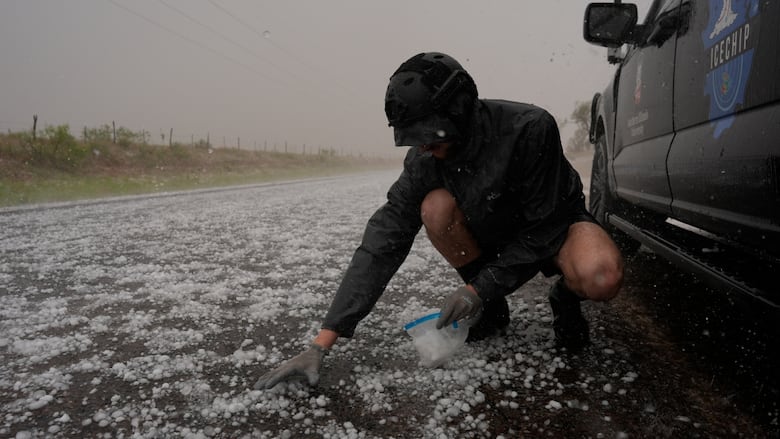Hail-focused research projects 'long past due' in Canada, U.S., prof says
Projects aim to minimize damage by better predicting hailstorms, hailstone sizes

A new project that aims to better predict when hail will hit and how big it will be might save people big bucks in damage repairs someday.
Project ICECHIP (In-situ Collaborative Experiment for the Collection of Hail In the Plains) involved dozens of researchers who spent six weeks chasing, driving and running into storms across the Great Plains in the U.S. to collect fresh hail and study it by measuring, weighing, slicing and crushing the stones to reveal what's inside.
Researchers hope the hailstones will reveal secrets about storms, damage and maybe the air itself.
The research was done to help improve radar-based hail detection, hail models and forecasting. The aim is to better predict hailstorms and lessen the costly damage they cause.
The project, which was the largest hail-focused study in the U.S. in over four decades, involved two teams of researchers, 15 different research institutions and three international partners — including Canada's Northern Hail Project.
Becky Adams-Selin, Project ICECHIP's lead principal investigator, says although hail is a worldwide problem, it hasn't gotten much attention until recent decades because it "doesn't kill people like tornadoes do."
"There was a lot of focus on tornadoes first to kind of get that warning system down, which makes sense," she said. "Hail didn't really start hitting people's pocketbooks until maybe the last two decades."
40,000 hail-related claims
Hail, combined with urban sprawl and deteriorating roofing materials, has created "a perfect storm," she said, and insurance companies are starting to feel the pinch.
"It's become a lot more evident that some of the things we don't know about hail are really causing a lot of problems," Adams-Selin said.
Data from Manitoba's public auto insurer suggests how the number of hailstorms has varied in the province over the last five years.
Manitoba Public Insurance says it has received over 40,000 hail-related claims since 2021. There were 1,300 hail-related claims in 2021 and nearly 3,700 claims in 2022, but the number skyrocketed in 2023, with nearly 28,000 claims submitted. It received almost 9,300 hail-related claims in 2024.
So far this year, MPI has gotten just over 700 claims submitted as of Friday.
Hail-packed thunderstorms that hammered Winnipeg last year led MPI to open a temporary hail-damage estimate centre in order to deal with a barrage of claims, on top of claims from a massive storm in Winnipeg in August 2023 that brought golf-ball-sized hail to some areas, MPI said.
Hail-focused research in Canada and the U.S. is "long past due," said John Hanesiak, a professor at the University of Manitoba's department of environment and geography who works with the Northern Hail Project, which is conducting similar research in Alberta this summer.
"This is sort of one of the first projects that's been dedicated to hail [in the U.S.] in 40 years, and the same thing can be said in Canada," he said.
Canada's last major hail-focused research project was the Alberta Hail Project, which ran from 1956 to 1985, Hanesiak said.
Predicting when hail will hit and how big it will be is "an evolving science," but cutting open a hailstone and analyzing its shape and density can give researchers a better idea of how it grew, he said.
"If we're able to measure at the ground, if we're able to measure the size distributions of the hail and collect hailstones from real storms, we can much better understand how they grow in certain conditions."

Weather balloons can also help researchers understand what meteorological conditions produce specific hailstorms and hail sizes, but Hanesiak said weather balloons are limited in Canada. The balloons gather weather data from the upper atmosphere, including temperature, humidity and air pressure.
In southern parts of Saskatchewan and Manitoba, there are no readings from weather balloons, he said.
Hanesiak said his hope is that the projects will help researchers determine whether there are any differences between American and Canadian hailstorms.
Keith Porter, chief engineer at the Ontario-based Institute for Catastrophic Loss Reduction, which partially funds the Northern Hail Project, says hail is rarely deadly but can be extremely costly.
A Calgary hailstorm in August was Canada's most destructive weather event of 2024, damaging homes, businesses, cars and the Calgary International Airport, resulting in $3 billion in insured losses, according to Catastrophe Indices and Quantification, which provides data to the insurance industry.
The best way to protect property from hail damage is by parking in a garage and installing impact-resistant roofing and siding on houses and other buildings, Porter said.
"The research helps us to tell [people] what the benefit of doing that is, why they should do it, [and] what's in it for them to save."
Porter said hail damage is everyone's problem.
"We are all in this problem together," he said. "Even if somebody else's neighbourhood gets damaged by a hailstorm, you are going to pay higher insurance premiums as a consequence."
With files from Marshal Hodgins and The Canadian Press

